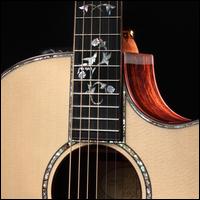Taylor 914ce Guitar
![]()
![]()
![]()
![]()
![]()
![]()
![]()
![]()

Looking like it just time-warped in from the middle of the high renaissance, the Taylor 914ce is breathtaking to stare at, and a bit daunting if you have a credit card in your pocket while you’re doing so. Its superb choice of tone woods and ornate decoration, however, will seem as naught once you start actually playing one.
Subtle, nuanced and intricate, the 914ce is stunning, especially if you favor fingerstyle playing.
All the guitars in Taylor’s current stable of hand-made instruments are a treat to play, and they grow more remarkable with their increasing model numbers. The 914ce represents everything they do cranked up to ten. Built of Indian rosewood for its back and sides, and a sitka spruce top, it reflects the complex sonic textures of a traditional acoustic guitar with the laser-straight neck of an electric instrument, and flawless intonation.
Unlike traditional hand-made guitars, much of the basic fabrication of Taylor’s instruments is performed by computer-controlled manufacturing technology. Skilled guitar builders select the source wood and then assemble the resulting instruments by hand. Aside from mitigating the traditionally stratospheric prices of hand-made guitars, Taylor’s unconventional approach to luthiery results in instruments with no rough edges, bad notes or funky noises.
The 914ce is an auditorium-size guitar. It’s somewhat smaller than a conventional dreadnaught. While it’s marginally quieter than a dreadnaught, it lacks the booming “echo chamber” sound of an instrument with a larger body, and it plays with a degree of balance that really big guitars never quite seem to manage.

The 914ce combines Taylor’s manufacturing technology with individually-selected wood and a flawless top. It also features some exceptional appointments. Fitted with Taylor’s custom Expression pickup system, it still sounds like an acoustic guitar even if it’s plugged into an amplifier or a recording system, rather than the “electric piano from WalMart” sound favored by most acoustic pickups. Its tuners are unplated brass – which look really cool compared to the gold or chrome plating usually found on high-end instruments – and they feature a high gear ratio that allows them to be precisely adjusted without the application of any quantum physics.
All this not withstanding, the intricate neck and body inlay of the 914ce are what just about everyone notices when I play this axe. It enjoys abalone shell trim around its soundboard, and abalone details on its bridge and neck. Despite the sense that it could probably be seen in total darkness as a result of all its ornamentation, the inlay of the 914ce has been carried off with a degree of reserve and artistry, and it successfully avoids the bling of many heavily inlaid instruments.
Shopping for a 914ce proved to be a somewhat more time-consuming experience than I’d originally anticipated, in that while they’re all exceptional, each 914ce has its own personality. I checked out several before I settled on mine. While this clocked up a lot of mileage, it did offer the opportunity to find a perfect guitar amid a field of perfect guitars. It was also a good excuse to play with a lot of really superb toys, of course.
If you live somewhere less remote than northern Canada, you probably won’t have to drive all day to scope these things out.
With a street price of about four thousand dollars, the Taylor 914ce is surprisingly affordable for what it is – what it is being a perfect hand-made instrument with little apparent concern having been given to the cost of the wood it was crafted from. Everything about it looks and sounds like it should have beat up my plastic for about twice what it did – it even smells expensive.
As sweet as it sounded when I bought it, it has begun to open up and find its voice since it arrived. It blows me away every time I pick it up.